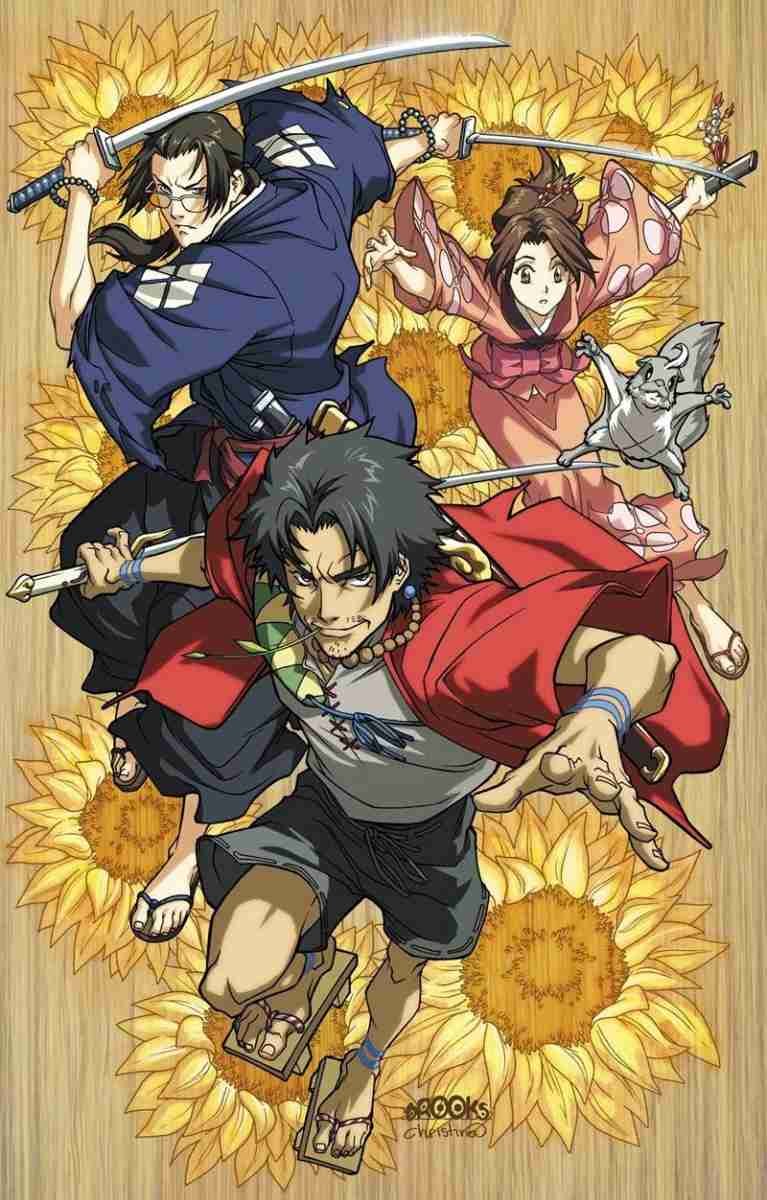A Unique Cultural Blend
Samurai Champloo, created by Shinichirō Watanabe, is a daring work that blends traditional Japanese culture with modern elements in a unique artistic fusion. Set during the Edo period (1603-1868), the anime draws inspiration from this era of relative peace under the Tokugawa shogunate, while enriching it with contemporary references like hip-hop, graffiti, and street fights. It’s a deliberately anachronistic journey through ancient Japan.
Unconventional Characters, Classic Quest
The story follows three characters: Mugen, a brutal vagabond with an unpredictable fighting style; Jin, a calm and disciplined ronin; and Fuu, a young waitress who drags them on a quest across Japan to find “the samurai who smells of sunflowers.” While the plot seems classic, its execution defies all conventions of traditional historical narratives.
The series draws its essence from the Edo period, but approaches it with artistic freedom. We see authentic elements like han (feudal domains), local lords, shogunate checkpoints, traveling artisans, geishas, and teahouses – all creating a credible historical backdrop. Yet each episode inserts modern references that break conventions.

Hip-Hop Meets Historical Japan
This blend extends to the music. The hip-hop soundtrack by Nujabes gives an urban, rebellious soul to the universe. This deliberate musical break from traditional Japanese sounds creates a powerful contrast with the historical context. It’s precisely this dissonance that gives Samurai Champloo its identity: an ancient Japan pulsating with modern, youthful energy.
The anime doesn’t shy away from concrete historical realities. It addresses the persecution of Japanese Christians, xenophobia toward foreigners, the rise of commerce, class conflicts, and the oppression of women. Each theme is treated with both critical and poetic perspective, highlighting the contradictions of this feudal society.
Combat Styles as Cultural Metaphors
The fights in Samurai Champloo are historically influenced but stylized for the series. Sword duels aren’t glorified – they’re often messy, quick, and brutal. Mugen’s style, inspired by capoeira and street arts, contrasts with Jin’s rigid kenjutsu katas. These stylistic oppositions represent two visions of Japan: instinct versus tradition.
The journey across Japan becomes a metaphor for the country’s cultural diversity. The heroes traverse varied landscapes, from coastal towns to rural mountains, encountering minorities, outcasts, and marginalized people. This focus on forgotten layers of Edo society reveals an implicit critique of the era’s social and political norms.

Art as Resistance Across Centuries
One particularly striking episode features graffiti – pure anachronism – but draws parallels between modern street artists and historical ukiyo-e printmakers. Here, art becomes a tool of protest. The message is clear: creativity, whether past or present, remains an act of resistance and identity.
The visual language of Samurai Champloo reinforces this cultural hybridization. The openings, transitions, manga-inspired freeze frames, and typography all reference both traditional Japan and hip-hop culture. This is a series that proudly bridges two worlds: tradition and modern urban culture.
Modern Feminism in Feudal Japan
The character of Fuu, often relegated to secondary roles in other works, embodies a certain modern femininity here. She’s neither a simple victim nor an overpowered heroine, but an individual with her own choices, willpower, and fragility. She may represent modern Japan in this trio, facing two male figures who embody a clashing past.
In summary, Samurai Champloo is much more than a quirky samurai anime. It’s a work deeply rooted in Japanese history and culture that chooses to express this richness through an anachronistic, vibrant lens. It pays homage to the past by confronting it with the present, successfully making tradition and subversion coexist in the same narrative – a risky bet that paid off brilliantly.

SAMURAI CHAMPLOO – A Bold Fusion of Edo-Era Japan and Modern Hip-Hop Culture
Table of Contents
A Unique Cultural Blend
Samurai Champloo, created by Shinichirō Watanabe, is a daring work that blends traditional Japanese culture with modern elements in a unique artistic fusion. Set during the Edo period (1603-1868), the anime draws inspiration from this era of relative peace under the Tokugawa shogunate, while enriching it with contemporary references like hip-hop, graffiti, and street fights. It’s a deliberately anachronistic journey through ancient Japan.
Unconventional Characters, Classic Quest
The story follows three characters: Mugen, a brutal vagabond with an unpredictable fighting style; Jin, a calm and disciplined ronin; and Fuu, a young waitress who drags them on a quest across Japan to find “the samurai who smells of sunflowers.” While the plot seems classic, its execution defies all conventions of traditional historical narratives.
The series draws its essence from the Edo period, but approaches it with artistic freedom. We see authentic elements like han (feudal domains), local lords, shogunate checkpoints, traveling artisans, geishas, and teahouses – all creating a credible historical backdrop. Yet each episode inserts modern references that break conventions.
Hip-Hop Meets Historical Japan
This blend extends to the music. The hip-hop soundtrack by Nujabes gives an urban, rebellious soul to the universe. This deliberate musical break from traditional Japanese sounds creates a powerful contrast with the historical context. It’s precisely this dissonance that gives Samurai Champloo its identity: an ancient Japan pulsating with modern, youthful energy.
The anime doesn’t shy away from concrete historical realities. It addresses the persecution of Japanese Christians, xenophobia toward foreigners, the rise of commerce, class conflicts, and the oppression of women. Each theme is treated with both critical and poetic perspective, highlighting the contradictions of this feudal society.
Combat Styles as Cultural Metaphors
The fights in Samurai Champloo are historically influenced but stylized for the series. Sword duels aren’t glorified – they’re often messy, quick, and brutal. Mugen’s style, inspired by capoeira and street arts, contrasts with Jin’s rigid kenjutsu katas. These stylistic oppositions represent two visions of Japan: instinct versus tradition.
The journey across Japan becomes a metaphor for the country’s cultural diversity. The heroes traverse varied landscapes, from coastal towns to rural mountains, encountering minorities, outcasts, and marginalized people. This focus on forgotten layers of Edo society reveals an implicit critique of the era’s social and political norms.
Art as Resistance Across Centuries
One particularly striking episode features graffiti – pure anachronism – but draws parallels between modern street artists and historical ukiyo-e printmakers. Here, art becomes a tool of protest. The message is clear: creativity, whether past or present, remains an act of resistance and identity.
The visual language of Samurai Champloo reinforces this cultural hybridization. The openings, transitions, manga-inspired freeze frames, and typography all reference both traditional Japan and hip-hop culture. This is a series that proudly bridges two worlds: tradition and modern urban culture.
Modern Feminism in Feudal Japan
The character of Fuu, often relegated to secondary roles in other works, embodies a certain modern femininity here. She’s neither a simple victim nor an overpowered heroine, but an individual with her own choices, willpower, and fragility. She may represent modern Japan in this trio, facing two male figures who embody a clashing past.
In summary, Samurai Champloo is much more than a quirky samurai anime. It’s a work deeply rooted in Japanese history and culture that chooses to express this richness through an anachronistic, vibrant lens. It pays homage to the past by confronting it with the present, successfully making tradition and subversion coexist in the same narrative – a risky bet that paid off brilliantly.